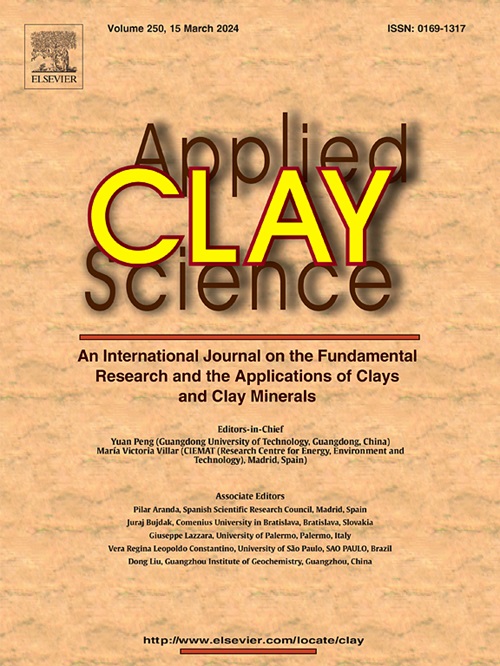蒙脱石复水化动力学及其在膨润土吸水中的应用
IF 5.3
2区 地球科学
Q2 CHEMISTRY, PHYSICAL
引用次数: 0
摘要
本研究调查了同离子模型蒙脱石和各种膨润土脱水后的再水化动力学,解决了脱水和再水化温度以及层间阳离子类型如何影响这一过程的理解空白,这在涉及膨胀粘土及其工业应用的基础研究中至关重要。结果表明,较高的脱水温度降低了再水化的程度,并与层电荷的减少有关,特别是在与二价阳离子交换的蒙脱石中。这与层间小阳离子的固定有关,导致高电荷层坍塌,因此反应进展较慢。蒙脱石表现出快速的初始再水化,然后是缓慢的平衡阶段。在典型的实验室条件下(20°C,相对湿度= 30%),25%的水在几分钟内被重新吸收,而90%的水在4小时内被重新吸收,这强调了在实验过程中防止再水化的必要性,以确保各种测量的准确性。无论实验条件如何,反应曲线均拟合为收缩和二维/三维扩散动力学模型。再水合的活化能(~ 50-70 kJ/mol)与脱水的活化能相当,反映了克服紧密结合水吸附/解吸的类似能量障碍。值得注意的是,膨润土表现出与蒙脱石相似的再水化行为,其动力学也受到蒙脱石层电荷的影响。模型蒙脱石和膨润土行为的相似性将有助于预测高放射性废物地下储存库中膨润土屏障的长期再水化行为。本文章由计算机程序翻译,如有差异,请以英文原文为准。
Kinetics of rehydration in smectite and its application to water resorption in bentonites
This study investigated the rehydration kinetics of homoionic model smectites and various bentonites following dehydration, addressing gaps in the understanding of how both dehydration and rehydration temperature and the type of interlayer cation affect this process, critical in basic studies involving swelling clays and in their industrial applications. The results showed that higher dehydration temperatures reduced the extent of rehydration and were correlated with a decrease in layer charge, particularly in smectites exchanged with divalent cations. This was linked to the fixation of small interlayer cations, resulting in the collapse of high-charge layers and, therefore, slower reaction progress. Smectites exhibited fast initial rehydration followed by slow equilibration stage. Under typical laboratory conditions (20 °C, RH = 30 %), 25 % of water was readsorbed within several minutes whereas 90 % - within four hours, emphasizing the necessity to prevent rehydration during experiments to ensure accuracy of various measurements. Regardless of the experimental conditions, reaction profiles were fitted to contraction and 2D/3D diffusion kinetic models. The activation energy for rehydration (∼50–70 kJ/mol) was comparable to that of dehydration, reflecting similar energy barriers in overcoming adsorption/desorption of tightly bound water. Notably, bentonites exhibited rehydration behaviour similar to that of smectites, with the kinetics also influenced by the layer charge of the smectites. Similarities in behaviour of model smectites and bentonites will aid in predicting the long-term rehydration behaviour of bentonite barriers in high-level radioactive waste underground repositories.
求助全文
通过发布文献求助,成功后即可免费获取论文全文。
去求助
来源期刊

Applied Clay Science
地学-矿物学
CiteScore
10.30
自引率
10.70%
发文量
289
审稿时长
39 days
期刊介绍:
Applied Clay Science aims to be an international journal attracting high quality scientific papers on clays and clay minerals, including research papers, reviews, and technical notes. The journal covers typical subjects of Fundamental and Applied Clay Science such as:
• Synthesis and purification
• Structural, crystallographic and mineralogical properties of clays and clay minerals
• Thermal properties of clays and clay minerals
• Physico-chemical properties including i) surface and interface properties; ii) thermodynamic properties; iii) mechanical properties
• Interaction with water, with polar and apolar molecules
• Colloidal properties and rheology
• Adsorption, Intercalation, Ionic exchange
• Genesis and deposits of clay minerals
• Geology and geochemistry of clays
• Modification of clays and clay minerals properties by thermal and physical treatments
• Modification by chemical treatments with organic and inorganic molecules(organoclays, pillared clays)
• Modification by biological microorganisms. etc...
 求助内容:
求助内容: 应助结果提醒方式:
应助结果提醒方式:


